ICSE Set Qa1 Year Icse Physics2000 Qa1.php Physics Exam Paper for students online
PART I
Q1) Answer all questions
briefly and to the point:- (Marks 20)
(i) State Gauss's theorem of electrostatics.
(ii) An alpha particle is accelerated through a potential difference of 2000
volt. What will be the increase in its energy in electron volt?
(iii) Assuming the earth as an isolated spherical conductor of radius 6400 km,
calculate its electrical capacitance in farad.
(iv) If the potential difference applied across a variable resistor is constant,
draw a graph between the current in the resistor and the resistance.
(v) Find the equivalent resistance between the point 'a' and 'c' of the given
network of resistors (See Fig. 1).
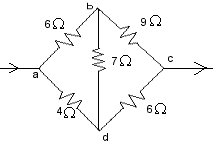
(vi) Show with a labelled graph how thermo-emf varies with the temperature of
the hot junction of a thermocouple.
(vii) What is the function of shunt in an ammeter?
(viii) What is meant by 'Wattless' current?
(ix) Name the physical principle and one advantage in the use of optical fibers.
(x) Can two independent monochromatic source of light be coherent? Explain very
briefly.
(xi) What is the relation between the refractive indices n1 and n2
if the behaviour of light rays is as shown in the following Fig. 2?

Here n1 and n2 are the refractive indices of the
surrounding medium and the lens respectively.
(xii) What is the principle of global communication by satellites?
(xiii) State Brewster's law for polarisation of light.
(xiv) Two thin lenses-one convex and the other concave - of focal lengths 15 cm
and 20 cm respectively are put in contact. Find the focal length of the doublet
lens.
(xv) Two stars three and four light years away from the earth have same luminous
intensity. Find the ration of the illuminance (intensity of illumination) on the
surface of the earth, normal to the starlight, produced by each star.
(xvi) The historic experiment on the diffraction of electron confirmed a new
nature of electron. What is this new nature of electron? Who had proposed it?
(xvii) Explain briefly why there is a maximum frequency for the X-rays produced
by an X-ray tube operating at a certain voltage.
(xviii) Draw circuit diagrams to illustrate forward biasing and reverse biasing
of a diode.
(xix) Name two alternative sources of energy and mention where they can be used.
(xx) The half-life period of a radioactive substance is 16 hours. After how much
time will 6.25% of the material remain undecayed?
Ans1) (i) Gauss's theorem of
electrostatics states that the surface integral of electrostatic field produced
by any sources over any closed surface enclosing a volume in free space i.e.,
total electric flux over the closed surface in free space, is 1/![]() o
times the total charge contained inside the surface i.e.,
o
times the total charge contained inside the surface i.e.,
![]()
![]() .
.![]() = q/
= q/![]() o
o
(ii) Increase in energy = qV
= 2 x 1.6 x 10-19 x 2000 V
= 2 x 2000 eV = 4000 eV
(iii) For an isolated spherical conductor, capacitance is given by
C = 4![]()
![]() oR
oR
R = 6400 Km = 6.4 x 106 m
C = 6.4 x 106/9 x 109 = 7.11 x 10-4 F
(iv)

(v)
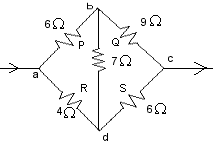
P/Q = R/S, hence this is a balanced wheatstone network. No current flows
through 7![]() resister. Thus 7
resister. Thus 7![]() resister becomes ineffective. Thus P & Q are in series. Thus equivalent is
equal to 6 + 9 = 15
resister becomes ineffective. Thus P & Q are in series. Thus equivalent is
equal to 6 + 9 = 15![]() R &
S are in series. Their equivalent is equal to 4 + 6 = 10
R &
S are in series. Their equivalent is equal to 4 + 6 = 10![]()
Now 15![]() & 10
& 10![]() are in parallel. Their equivalent resistance 'R' is given by
are in parallel. Their equivalent resistance 'R' is given by
1/R = 1/15 + 1/10 = 1/6
or R = 6![]()
(vi)
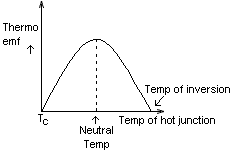
(vii) Shunt protects ammeter from strong currents. Shunt is a low
resistance connected in parallel with galvanometer and this combination acts as
an ammeter. A major portion of the current passes through this low resistance
and only a small portion passes through the galvanometers. Since the shunt
permits a small fraction of the main current to pass through the galvanometers
and keeps the overall resistance of the instrument very low, an ammeter formed
will not alter appreciably the original current of the circuit in which it is
introduced and it will be able to handle even larger currents.
(viii) Wattless current is that which involves no consumption of power
for its maintenance in the circuit.
(ix) Optical fibers are based on the phenomenon of total internal
reflection.
Advantage in the use of optical fibers: optical fibers can transmit telephone
calls & television programmes for long distance without much loss and less
electrical interference.
(x) Two independent monochromatic sources of light cannot be coherent.
This is because light is emitted from individual atoms, when they return to
ground state after being excited. A source of light contains billions of such
atoms which cannot emit light waves in same phase.
(xi) n2 < n1
(xii) For the global communication geostationary satellites are used.
These satellites are linked with the ground stations as well as with each other.
Such satellites, together with certain other satellites forming a group called
constellation of satellites, help to maintain worldwide transmission of T.V.
programmes and telephone signals.
(xiii) Brewster's law for polarisation of light states that when
unpolarised light is incident at polarising angle, ip. on an
interface separating air from a medium of refractive index ![]() , then
, then ![]() = tan ip
= tan ip
(xiv) Focal length of convex lens (f1) = 15 cm
Focal length of concave lens (f2) = -20 cm
Focal length of the doublet lens (f) is given by
1/f = 1/f1 + 1/f2
or 1/f = 1/15 - 1/20 = 1/60
or f = 60 cm
(xv) I1 = I2 (same luminous intensity)
E1r12 = E2r22
or E1/E2 = r22/r12
= (4/3)2 = 16 : 9
(xvi) The new nature of electrons is the wave nature. This was proposed
by De Broglie.
(xvii) X-rays are produced when the kinetic energy of the incident
electrons is transmitted into electromagnetic radiation upon collision with
atoms. Before being stopped, electrons make several collisions & produce
photons of all frequencies. Photons of largest frequency is produced when an
electron makes a head-on collision with atom & loses all of its energy. For
such a collision photon frequency is maximum as energy transferred is maximum.
(xviii)


(xix) Two alternative sources of energy are - wind and solar energy.
Wind energy is used in wind mill which converts wind energy into useful
mechanical energy and to turn the shaft of an electrical generator. Thus a chain
of wind mills can produce electricity.
Solar energy can be used in solar cells, solar cooker, solar furnace & solar
heater.
(xx) T1/2 = 16 hours
N/No = 6.25% = 1/16
No of atoms left after n half-lives is given by
N = No (1/2)n
N/No = (1/2)n or 1/16 = (1/2)n
2n = 16 or n = 4
No. of half lives = time of disintegration (t) / half life period (T1/2)
t = n T1/2 = 4 x 16 = 64 years
Q 2) (a) Derive an expression
for the electric potential at a point due to a point charge. (Marks 4)
Q 2 (b) An electric flash lamp has 20 capacitors each of capacitance 5![]() F
connected in parallel. The lamp is operated at 100 volt. Calculate how much
energy will be radiated in a flash. (Marks 3)
F
connected in parallel. The lamp is operated at 100 volt. Calculate how much
energy will be radiated in a flash. (Marks 3)
Q 2 (c) Name one material whose resistivity decreases with rise in temperature.
Explain briefly on the basis of free electron theory why the resistivity
decreases. (Marks 2)
Ans. 2 (a) Electric potential at a point due to a point charge:
Consider a point charge +q located at O and let P be the point where electric
potential is to be calculated

At any point A on the line joining OP, where OA = x, the electric intensity is
E = (1/4![]()
![]() o)
. (q/x2), along OA produced small amount of work done in moving a
unit positive charge from A to B where AB = dx is
o)
. (q/x2), along OA produced small amount of work done in moving a
unit positive charge from A to B where AB = dx is
dW = -E dx
Total work done in moving unit +ve charge from ![]() to the point which is equal electric potential at point P is
to the point which is equal electric potential at point P is
potential = W = ![]() dW
dW
| r = |
r -Edx = |
-(1/4 |
= -q/4![]()
![]() o
[-1/x]r
o
[-1/x]r![]()
= q/4![]()
![]() o
r
o
r
Ans. 2 (b) Capacitance 'C' = 5 ![]() F
= 5 x 10-6 F
F
= 5 x 10-6 F
v = 100 V
Energy of each capacitor = 1/2 CV2
= 1/2 x 5 x 10-6 x (100)2
= 2.5 x 10-2 J
Total energy = 20 x 2.5 x 10-2
= 5 x 10-1 J
Ans. 2 (c) Resistivity of semiconductor like silicon and germanium
decreases with the rise in temperature with the increase in temperature the
number density of free electrons & holes increases & hence resistivity
decreases.
Q 3 (a) State and explain
Kirchoff's laws for electric circuits. What are the conservation laws implied in
each law? State the sign convention for current and emf. Use the Fig. 3 given
below for your explanation. (Marks 4)
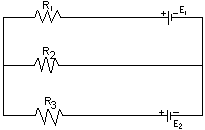
Q 3 (b) An electron is moving vertically upwards in the uniform magnetic
field of the earth. The velocity of the electron is 2.0 x 106 m/s and
the horizontal component of earth's magnetic field is 0.32 x 10-4
tesla. Obtain the magnitude and direction of the force on the electron. (Marks
3)
Q 3 (c) Permanent magnets are made of special alloy while the core of temporary
magnets are made of soft iron. Why? (Marks 2)
Ans. 3 (a) Kirchoff's first law or Kirchoff's junction law:
It states that the algebraic sum of the currents meeting at a junction in a
closed circuit is zero.
This law is based on the fact that charges are not accumulated at a junction. A
point in a circuit cannot act as a source or sink of charges.
Sign convention for I law - The current flowing in a conductor towards the
junction is taken as positive and the current flowing away from the junction is
taken as negative. Consider the following diagram.
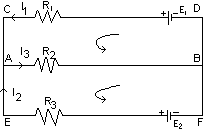
At junction A, I1 and I2 are +ve and I3 (-ve).
According to kirchoff's I law
I1 + I2 - I3 = 0
or I1 + I2 = I3
Kirchoff's second law or Kirchoff's Loop law:
It states that in any closed path of an electrical circuit (or closed loop), the
algebraic sum of the e.m.f. is equal to the algebraic sum of the products of the
resistances & the respective currents flowing through them.
The second law supports the law of conservation of energy i.e. the net change in
the energy of the charge, after the charge completes a closed path must be zero.
Sign convention for II law: Traverse a closed path of a circuit in clockwise or
anticlockwise direction.
(i) The emf of a cell is taken positive if one moves in the direction of
increasing potential (i.e. from -ve to +ve pole) through the cell & is taken
-ve if one moves in the direction of decreasing potential (i.e. from +ve to -ve
pole) through the cell.
(ii) The product of resistance & current in an arm of the circuit is taken +ve
if the direction of current in that arm is in the same sense as one moves in a
closed path & is taken -ve if the direction of current in that arm is
opposite to the sense as one moves in a closed path.
In the given diag let us apply II law it the closed path CABDC
E1 = I1R1 + I3R2
Similarly for the closed path AEFBA
-E2 = -I3R2 - I2R3
Ans. 3 (b) F = qVB sin ![]()
q = 1.6 x 10-19 C
V = 2 x 106 m/s
B = 0.32 x 10-4 T
![]() = 90
= 90
F = 1.6 x 10-19 x 2 x 106 x 0.32 x 10-4 x sin
90
1.024 x 10-17 N
The direction of force on electron is from East to West.
Ans. 3 (c) Permanent magnets are made of special alloys because of their
high retentivity & high coercivity.
The core of temporary magnets are made of soft iron. This is because
(i) soft iron has large initial permeability so that large magnetic induction is
obtained at relatively smaller valves of magnetising field.
(ii) soft iron has smaller coercivity so that magnetism is lost easily.
Q 4 (a) Define self
inductance. Obtain the expression for the self inductance of a solenoid,
explaining steps with the help of a diagram. (Marks 3)
Q 4 (b) What is meant by back emf in a dc motor? The back emf in a dc motor,
delivering 3 kilowatts of mechanical power, is 180 volts when operating on 220
volt line. Determine the armature current and the motor resistance. (Marks 3)
Q 4 (c) In an LCR circuit with all components connected in series, the emf and
the current flowing in the circuit are given by the following equations:-
![]() = 200 sin (314t +
= 200 sin (314t + ![]() /6)
volts
/6)
volts
I = 5 sin 314 t ampere
Obtain:
(i) the peak values of current and emf.
(ii) the frequency of the ac source.
(iii) the phase difference between current and emf. (Marks 3)
Ans4) (a) The self inductance of a coil is equal to the emf induced in the
coil when rate of change of current through the coil is unity.
Self inductance of a solenoid
The magnetic field at any point inside a solenoid is given by
B = (![]() oN/L) I
oN/L) I
where L is length of solenoid
I is current through solenoid
N is total no of turns in the solenoid
Magnetic flux through each turn of the solenoid coil
= ![]() .
. ![]()
= B x Area of each turn
= BA

Total flux linked with the solenoid
= flux through each turn x total no of turns
![]() =
= ![]() oNIAN//L
= ((
oNIAN//L
= ((![]() oN2A)/L)I
- (i)
oN2A)/L)I
- (i)
comparing eq (i) with ![]() = LI
we get
= LI
we get
L = ![]() oN2A/l
oN2A/l
Ans. 4 (b) During the operation of a motor, the armature has to rotate in
the magnetic field. As the armature rotates, the magnetic flux linked with the
coil changes and an emf is induced in the coil which opposes the applied emf.
Total induced emf is called back emf.
Output power (P) = 3 KW = 3000 W
Back emf (E) = 180 V
Applied emf (V) = 220 V.
P = IE
3000 = I x 180
or I = 3000/180 = 50/3 A
Also I = (V - E)/R
or R = (V - E)/I = (220 - 180)/(50/3) = 12/5 = 2.4![]()
Ans. 4 (c) ![]() = 200 sin
(314 t +
= 200 sin
(314 t + ![]() /6) volt
/6) volt
I = 5 sin (314 t) Amperes
(i) Io = 5A, ![]() o = 200V
o = 200V
(ii) ![]() = 314 = 2
= 314 = 2![]()
![]()
![]() = 314/2
= 314/2![]() = 314/ 2 x 3.14 = 50 Hz
= 314/ 2 x 3.14 = 50 Hz
(iii) ![]() =
= ![]() /6
/6
Q 5 (a) State Huygens'
principle. Explain with the help of a diagram the phenomenon of refraction of
waves on the basis of this principle. (Marks 3)
Q 5 (b) What is chromatic aberration in lenses? State the necessary condition
for an achromatic doublet. How are these conditions practically achieved? (Marks
3)
Q 5 (c) Fraunhofer diffraction from a single slit of width 1.0 ![]() m
is observed with light of wavelength 500 nm. Calculate the half angular width of
the central maximum. (Marks 2)
m
is observed with light of wavelength 500 nm. Calculate the half angular width of
the central maximum. (Marks 2)
Ans. 5 (a) Huygen's principle states that
(i) Each point on a wavefront becomes a new source of secondary wavetels, which
spread out with the speed of light in that medium.
(ii) The new wavefront at any later-time is given by the forward envelope of the
secondary wavelets at that time.
Refraction on basis of Huygen's principle:
Let XY be a plane surface separating two media 1 and 2, the velocity of light
being c1 in the first medium and c2 in the second medium.
Suppose a plane wave front AB is incident on surface XY. It first strikes at A
and then the successive points towards c. Let i be the angle of incidence.
According to Huyghen's principle, from each point on AC, the secondary wavelets
start growing in the second medium with speed c2. Let the wave
disturbance take time t to travel from B to C, then BC = c1t. During
the time, the disturbance from B reaches the point C, the secondary wavelets
from point A must have spread over a hemisphere of radius AD = c2t in
the second medium. The tangent plane CD drawn from point C over this hemisphere
of radius c2t will be the new refracted wave front.
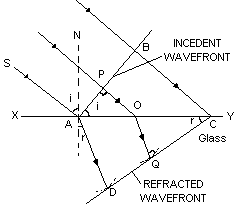
Consider a ray POQ normal to both the incident and the refracted wave fronts.
Let the angle of incidence and refraction be i and r, which can be taken as the
angles made respectively by the incident wave front AB and refracted wave front
CD with the surface of separation XY. For CD to be the true refracted wave
front, all the wave disturbances must take the same time in traveling from the
incidence wave front AB and wave front CD.
Now the total time taken by the ray to travel from P and Q
= PO/c1 + OQ/c2
= (AO sin i)/c1 + (OC sin r)/c2
= (AO sin i)/c1 + ((AC - AO) sin r)/c2
= (AC sin r)/c2 + AO[(sin i)/c1- (sin r)/c2]
Different rays from the incident wave front have different values of AO. Since
the time taken by these rays to reach the wavefront CD is same, the coefficient
of AO must vanish i.e.,
sin i/c1 = sin r/c2
or sin i/sin r = c1/c2 = Constant, n21
This proves Snell's law of refraction. The constant n21 is called the
refractive index of second medium with respect to the first medium.
Further, since the incident ray SA, the normal AN and refracted ray AD are
respectively perpendicular to the incident wave front AB, the dividing surface
XY and the refracted wavefront CD (all perpendicular to the plane of the paper),
therefore, they all lie in the plane of the paper, i.e., in the same plane. This
proves another law of refraction.
Ans. 5 (b) Chromatic Aberration: It is the defect in the quality of image
caused by the fact that the coloured images of an object illuminated by white
light are formed at different distances from the lens & they have different
sizes.
The necessary condition for an achromatic doublet is w/f + w '/f ' = 0
Where f & f ' are focal lengths of the two lenses and w & w' are
respectively their dispersive powers.
To achieve the above condition.
(i) the two lenses cannot be both convex or concave
(ii) the two lenses cannot be of the same material
Ans. 5 (c) width of slit, a = 1![]() m
= 10-6 m
m
= 10-6 m
![]() = 500nm = 5 x 10-7
m
= 500nm = 5 x 10-7
m
Half angular width (![]() ) is
given by
) is
given by
a sin ![]() =
= ![]()
sin ![]() =
= ![]() /a
= 5 x 10-7/10-6 = 0.5
/a
= 5 x 10-7/10-6 = 0.5
or ![]() = 30o
= 30o
Q 6 (a) Draw a neat ray
diagram of a simple microscope. Deduce the formula for its angular magnification
when the image is formed at the least distance of distinct vision. (Marks 3)
Q 6 (b) A beam of monochromatic light of wavelength 500 nm falls on two parallel
slits. The distance between the slits is 0.15 mm. Determine the width of the
interference fringes on a screen placed at a distance of 1.5 m from the slits.
(Marks 3)
Q 6 (c) Draw a sketch of electromagnetic spectrum, showing relative positions of
UV, IR, X-rays and microwaves with respect to visible light. State approximate
wavelengths of any two. (Marks 2)
Ans. 6 (a)
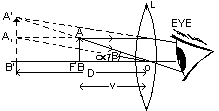
Angular magnification is the ratio of angle subtended by the image and the
object at the eye, when both are at the least distance of distinct vision from
the eye.
In the diagram imagine the object AB to be displaced to position AlBl
at a distance D from the lens
let ![]() AlOBI
=
AlOBI
= ![]() and
and ![]() AIOBI
=
AIOBI
= ![]()
Angular magnification 'm' = ![]() /
/![]() = tan
= tan ![]() /tan
/tan ![]() (
( ![]() ,
, ![]() are small angles)
are small angles)
= (AB/OB)/(AIBI/OBI) = (AB/OB)/(AB/OBI)
= OBI/OB = -D/-x = D/x
From the lens formula
1/f = 1/v - 1/u
u = -x , v = -D
1/f = 1/-D - 1/-x
or 1/x = 1/D + 1/f
D/x = 1 + D/f
m = 1 + D/f
Ans. 6 (b) Given ![]() = 500nm = 5 x 10-7 m
= 500nm = 5 x 10-7 m
d = 0.15 mm = 0.15 x 10-3 m
D = 1.5 m
Fringe width, ![]() =
= ![]() D/d
= (5 x 10-7 x 1.5)/(0.15 x 10-3)
D/d
= (5 x 10-7 x 1.5)/(0.15 x 10-3)
= 5 x 10-3 m
= 5 mm
Q 7 (a) With the help of neat
diagram describe with theory, Michelson's method for the determination of the
speed of light. What is the presently accepted nine digit value of the speed of
light? (Marks 4)
Q 7 (b) What is meant by pure and impure spectrum? Explain briefly how you will
set up a spectrometer to obtain pure spectrum. Draw a diagram of a spectrometer
and describe its parts. (Marks 4)
Ans. 7 (a) Michelson's method for the determination of speed of light
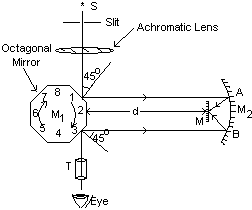
Construction: M1 is an octagonal steel mirror mounted on the
shaft of a variable speed motor. Light from a strong source S (an arc lamp)
passing through slit in rendered parallel by an achromatic lens L and falls at
an angle of 45░ on a face (say 1) of mirror M1 which reflects it to
a distant concave mirror M2. The beam incident at point A is
reflected towards a mirror M placed at the focus of M2. The beam
reflected by M is incident on point B of M2 which reflects it back
parallel to its own axis.
Method: When the mirror M1 is stationary, the reflected beam
strikes face 3 of M1 at the angle of 45░. This light is reflected
into the telescope T and see a continuous image of source S. When the mirror is
set into rotation start with a low speed, light returning to it from mirror M2
will not be incident angle of 45░, and hence will not enter the telescope. Thus
the image disappear. When the speed of rotation of M1 is suitably
adjusted, the image appears again the same position as when M1 is at
rest. This happens only when the speed rotation of M1 is such that
the next fact 2 of the mirror M1 is in position former occupied by
face 3, during the time light travels from M1 to M2 and
comes back to M1.
Calculations:
Let d = distance between M1 and M2,
n = number of revolutions of M per second, and
c = speed of light
... Time taken by light to travel from M1 to M2
and back = 2d/c
Time taken by M1 to complete one revolution = 1/n seconds
Time taken by M1 to complete 1/8th of a revolution = 1/8n seconds
For the image to appear again.
2d/c = 1/8n
c = 16 nd
Result of Michelson's experiment: In Michelson's experiment d ~ 3.5
km, n ~ 500 rps. Michelon's experiment gave a speed of light in air of
299729 km s-1.
The present nine digit value of the speed of light is 299792458 m/s.
Ans. 7 (b) Pure Spectrum: It is a spectrum in which there is no
overlapping of colours & each colour occupies a distinct vision.
Impure Spectrum: It is a spectrum in which the constituent colours of
different rays partially overlap each other.
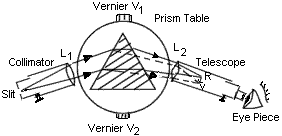
The main parts of a spectrometer are-
1. Collimator: It consists of two coaxial cylindrical tubes, one can slide
inside the other by rack & provision arrangement. The free end of inner tube
carries a slit of adjustable width & free end of outer tube carries an
achromatic lens combination.
2. Prism table: It is a horizontal metallic circular plate which is mounted
horizontally on a vertical stand of adjustable height. The free end of the stand
lies at the centre of main circular scale graduated in degrees. Two
diametrically opposite verniers V1 & V2 help to read accurately the position
of prism.
3. Telescope: It is an astronomical telescope. It is mounted horizontally on a
vertical stand attached to the main circular scale.
Setting of spectrometer:
1. Focussing the eyepiece. The telescope is turned towards a white wall and its
eyepiece is focused by moving the latter in and out so that the cross-wires are
clearly visible. The eyepiece is rotated to make one of its cross-wires
vertical.
2. Focussing the telescope for parallel rays. The telescope is turned towards a
distant object seen through an open window. The distance between the eyepiece
and the objective is adjusted till there is no parallax between the vertical
cross-wire and the distant object. The telescope is now set to receive the
parallel rays.
3. Focussing the collimator for parallel rays. The slit is illuminated with
bright source. The telescope is turned to bring it in the line with the
collimator. The slit is viewed through it. The distance between the slit and the
lens collimator is adjusted until the image of the slit is clearly seen with no
parallax between it and the vertical cross-wire. Now the width of the slit is so
adjusted that its image is just a sharp line. This sets the collimator to
provide a parallel beam of light.
4. Setting the prism. The prism is placed on the prism table so that its centre
coincides with the centre of the table.

The prism table is rotated so that light from the collimator falls on refracting
face AB and after refraction emerges from the other face AC. The prism causes
dispersion. The rays of a given colour emerge parallel to each other. They are
received by the telescope (already focussed at infinity). All red rays are
focussed at R, all violet rays at V and rays of other colours in between, and a
spectrum RV is formed in the focal plane of the objective. The spectrum, which
consists of coloured images of the slit is viewed through the eyepiece.
5. To get rid of overlapping of colours, the prism is set in the minimum
deviation position for some mean colour, say yellow colour. This gives a pure
spectrum.
Q 8 (a) The ionisation
potential of hydrogen atom is 13.6 volt. Draw the energy level diagram showing
four levels. Calculate
(i) the energy of the photon emitted when an electron falls from the third orbit
to the second orbit.
(ii) the wavelength of this photon. (Marks 4)
Q 8 (b) Described briefly with a diagram and theory an experiment to determine
e/m of electron. (Marks 4)
Ans. 8 (a)
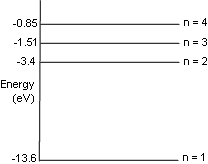
(i) Energy emitted = E3 - E2
= -1.51 - (-3.4) = 1.89 eV
(ii) E = hc/![]()
E = 1.89 eV = 1.89 x 1.6 x 10-19 J
![]() = hc/E = (6.6 x 10-34
x 3 x 108) / (1.89 x 1.6 x 10-19)
= hc/E = (6.6 x 10-34
x 3 x 108) / (1.89 x 1.6 x 10-19)
= 6.54 x 10-7 m
Ans. 8(b)
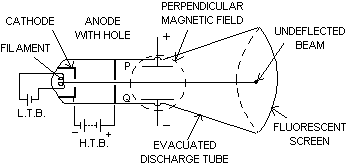
Thomson's method for the determination of e/m of an electron
Thomson's apparatus: It consists of a discharge tube evacuated to a
pressure of 0.01 mm of Hg. Its narrow portion contains a filament which emits
electrons when heated by a current from a low tension battery. The emitted
electrons are accelerated by applying a high voltage V between the cathode and
anode. A narrow beam of electrons emerges through a small hole in the anode,
which then enters a region of crossed electric and magnetic fields. The electric
field is produced by applying a suitable potential difference between two
parallel horizontal plates P and Q so that it acts perpendicular to the electron
beam and in the plane of paper. It deflects the electron beam upward. In the
region of electric field, a magnetic field is applied in a direction
perpendicular to the plane of paper and directed into the paper, as shown by
dotted circle. It deflects the electron beam in the downward direction. The
inside of the broader end of the tube is coated with a fluorescent material.
When the electron beam finally strikes the fluorescent screen, it marks a
luminous spot on the screen.
Working: The position of the cathode ray beam is first noted on the
fluorescent screen when no electric and magnetic fields have been applied. Now
both the fields E and B are applied and their strengths are so adjusted that the
beam is again incident on its undeflected position. This happens when the forces
due to the two fields balance each other.
Theory: Let m = mass of an electron
e = charge on an electron
V = potential difference between cathode and anode of discharge tube
v = velocity of the electron as it comes out of anode hole.
As the electron is accelerated from cathode to anode, its potential energy gets
converted into kinetic energy. Thus
P.E. of an electron at the cathode = Gain in its K.E. at the anode
eV = 1/2 mv2
or e/m = v2/2V
Force on an electron due to | r electric field E is
Fe = eE
Force on an electron due to | r magnetic field B is
Fm = evB
For the undeflected beam,
Fm = Fe
evB = eE
or v = E/B
Hence e/m = v2/2V = E2/2VB2
Knowing the values of E, V and B for the undeflected beam, the specific charge
e/m of the electron can be determined.
Q 9 (a) What is Compton
scattering? State briefly its importance. (Marks 2)
Q 9 (b) When ultraviolet light of wavelength 300 nm is incident on a metal
plate, a negative potential of 0.54 volt is required to stop the emission of
photo electrons. Calculate the energy of the incident photon and the work
function for the metal in eV. (Marks 4)
Q 9 (c) Draw the circuit diagram of a half wave rectifier using a semi-conductor
diode. Explain briefly the function of each component. (Marks 2)
Ans. 9 (a) Compton Scattering: It is the scattering of X-rays by
electrons, with an increase in wavelength.
Importance of Compton Scattering: It explains the particle nature of
light. The scattering was explained due to collision of incident photon with
electrons.
Ans. 9 (b) ![]() =
300nm = 300 x 10-9 m
=
300nm = 300 x 10-9 m
stopping potential (Vo) = 0.54 V
Energy of incident photons = hc/![]()
= (6.6 x 10-34 x 3 x 108) / (300 x 10-9)
= 6.6 x 10-19 J
= 4.12 eV
Ans. 9 (c) Half wave rectifier
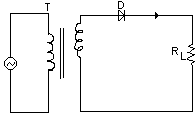
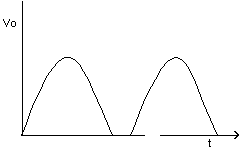
T is a transformer whose primary is connected to the a.c. supply & secondary
is connected to the diode. Transformer steps down a.c.
Diode conducts only in forward bias and helps in converting a.c. to d.c.
RL is load resistance across which output is taken.
Q 10 (a) Heavy water is
suitable moderator in a nuclear reactor. Explain briefly why? (Marks 2)
Q 10 (b) Draw labelled diagrams to illustrate
(i) energy bands of a conductor, semiconductor and insulator.
(ii) npn and pnp transistors.
(iii) transistor as an amplifier (common emitter). (Marks 4)
Q 10 (c) What do you mean by AND gate? How will you realise AND gate with
junction diodes?
(Marks 2)
Ans. 10 (a) Heavy water is a suitable moderator in a nuclear rector as it
does not absorb neutrons.
Ans. 10 (b) (i) Energy band Diagrams:
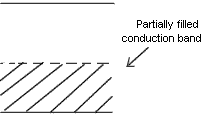 For Conductors |
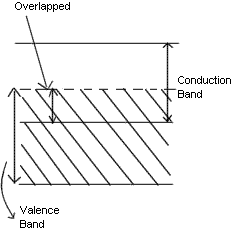 |
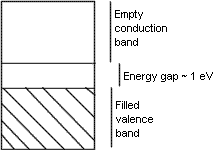
For semiconductor
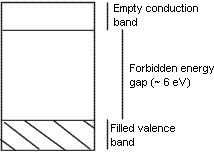
For insulators
(ii)

(iii) Transistor as an amplifier (common-emitter)

Ans. 10 (c) AND Gate: It is a device which has two or more inputs
& one output. It gives high output when both the inputs are high.
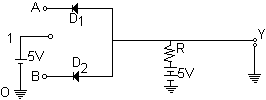 |
|
Operation
(i) When A & B are connected to earth (zero level), both D1 & D2 get
forward biased and hence conduct. The potential difference developed across the
resistance R will neutralize 5V battery sending the current in a direction
opposite to that due to the majority charge carriers. Hence Y will be at zero
level.
(ii) When A is earthed (Zero level) and B is connected to position of the
battery (1 level), D1 will conduct whereas D2 will not conduct. The output Y
will be at zero level.
(iii) When A is at 1 level i.e., connected to position of the first battery and
B is earthed, D2 will conduct whereas D1 will not conduct. This results in zero
level at Y again.
(iv) When A and B are both at level 1, none of the diodes will conduct. There
will be no potential difference across R and hence output Y will be equal to
battery voltage of 5 V (level 1).
This is AND circuit, output is at level 1 only when A and B are at level 1.

